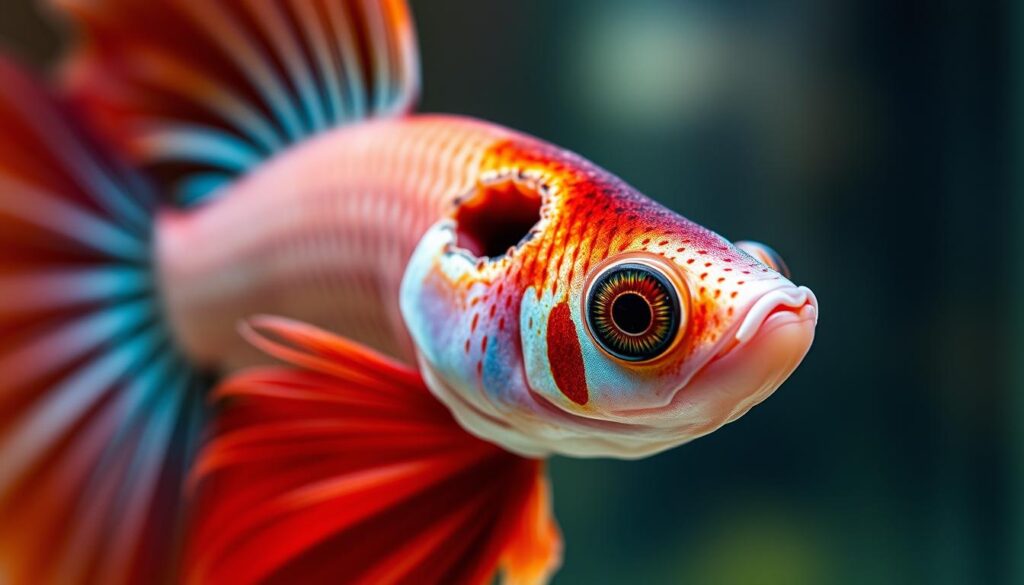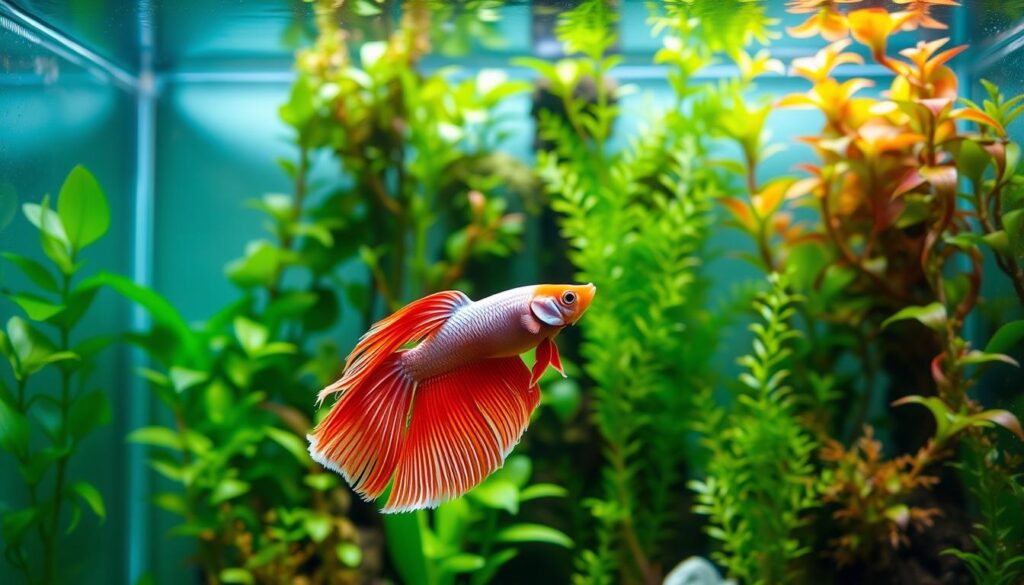If you’ve noticed strange pits or small holes forming on your Betta’s head, it could be a serious warning sign of hole-in-the-head-disease-betta-fish keepers need to watch out for.
Though rare in Bettas, this disease can be dangerous if left untreated. It’s usually linked to poor water quality, nutritional deficiencies, or internal parasites—and if ignored, it can turn fatal.
In this article, we’ll cover everything about hole in the head disease betta fish: what causes it, early symptoms to spot, and how you can treat and prevent it to protect your fish’s health.
We’re here to help you understand what’s behind this condition and how to treat it effectively. Betta fish health issues like hole-in-the-head disease can be caused by various factors, including poor water quality, inadequate diet, and stress. By identifying the root cause, you can take the right steps towards fish disease treatment and get your betta back to its vibrant self.
Key Takeaways
- Understanding the causes of hole-in-the-head disease in betta fish.
- Effective treatments for fish disease.
- Tips for maintaining optimal betta fish health.
- Preventing common health issues in betta fish.
- Improving your betta’s diet and environment for better health.
What You Need to Know About Betta Fish Health
As a betta owner, you’re probably aware that these beautiful fish can be prone to various health issues. Keeping your betta fish healthy requires a comprehensive approach that includes proper care, early disease detection, and a good understanding of their needs.
Common Betta Fish Health Challenges
Betta fish can suffer from a variety of health issues, including parasitic, bacterial, and fungal infections. Some of the most common diseases include hole in the head disease, fin rot, and ich. Understanding these conditions is crucial for providing the best care for your betta.
| Disease | Symptoms | Treatment |
|---|---|---|
| Hole in the Head | Lesions on the head, loss of appetite | Metronidazole, improved water quality |
| Fin Rot | Fins deteriorating, discoloration | Antibiotics, clean water conditions |
| Ich | White spots on the body, excessive swimming | Malachite green, salt baths |
The Importance of Early Disease Detection
Early detection is key to treating betta fish diseases effectively. Regularly inspecting your betta for signs of illness can make a significant difference in their recovery. As the saying goes, “An ounce of prevention is worth a pound of cure.” Regular monitoring and quick action can save your betta’s life.
“The health of your betta fish is directly related to the quality of care they receive. Regular water changes, a balanced diet, and a clean environment are essential.”
Betta Fish Care Fundamentals
Proper betta fish care involves maintaining good water quality, providing a balanced diet, and ensuring their tank is clean and spacious enough. Here are some fundamental care tips:
- Regular water changes (at least 25% weekly)
- A balanced diet that includes high-quality betta pellets and occasional treats
- A tank that is at least 5 gallons with proper filtration
By following these guidelines and staying vigilant, you can help prevent many common betta fish health issues and ensure your pet lives a long, healthy life.
Understanding Hole in the Head Disease in Betta Fish
If you’re a Betta fish owner, you’ve probably heard of Hole in the Head Disease – but do you know what it really is? This condition is a common issue in Betta fish, characterized by lesions or holes on the fish’s head or body. Let’s explore what causes it and how to identify the symptoms early.
hole in the head disease betta fish click here
What Exactly Is This Condition?
Hole in the Head Disease, also known as Hexamitiasis, is a parasitic infection caused by the protozoan parasite Hexamita. This microscopic parasite can weaken your Betta’s immune system, making it more susceptible to other infections.

How Hole in the Head Affects Betta Fish
The disease can cause significant discomfort to your Betta, leading to weight loss, lethargy, and in severe cases, even death. The lesions or holes on the head or body are not just cosmetic issues; they’re signs of an underlying infection that needs attention.
The Scientific Name: Hexamita/Hexamitiasis
Hexamitiasis is the scientific name for the condition caused by the Hexamita parasite. Understanding the scientific name helps in identifying the root cause of the disease and seeking appropriate treatment.
Related Conditions
It’s worth noting that Hole in the Head Disease can sometimes be accompanied by other health issues, such as bacterial infections or nutritional deficiencies. Identifying and treating these related conditions is crucial for the overall health of your Betta.
By understanding the causes and symptoms of Hole in the Head Disease, you can take proactive steps to protect your Betta fish and ensure they lead a healthy, happy life.
Recognizing the Symptoms of Hole in the Head Disease
Identifying the symptoms of hole in the head disease early on can be a game-changer for your betta fish’s health! As a responsible betta owner, you want to catch any issues before they become serious. So, what should you be looking out for?
Early Warning Signs to Watch For
The first signs of hole in the head disease can be subtle, but being vigilant can make all the difference. Look out for lethargy, where your betta seems less active than usual, and a loss of appetite, which can be a clear indicator that something’s amiss. You might also notice visible lesions or holes on your betta’s head, which is a telltale sign of the disease.
Advanced Symptoms and Disease Progression
As hole in the head disease progresses, the symptoms can become more severe. Your betta might start to show signs of faded colors or labored breathing. In advanced cases, the disease can lead to serious damage if left untreated. It’s crucial to monitor your betta’s condition closely and take action promptly.
Behavioral Changes in Affected Bettas
Bettas with hole in the head disease often exhibit behavioral changes. They might become more reclusive or show less interest in their surroundings. You might notice your betta hiding more often or avoiding interaction. These changes can be distressing, but recognizing them early can help you take the necessary steps to nurse your betta back to health.
Differentiating from Other Betta Diseases
It’s not always easy to diagnose hole in the head disease, as some symptoms can be similar to other betta illnesses. However, by closely observing your betta’s behavior and physical condition, you can make a more informed decision about their health. If you’re unsure, consulting with a fish expert or veterinarian can provide clarity.
Read Also Betta Fish New Tank Syndrome: Causes, Symptoms & How to Fix It Fast
Primary Causes of Hole in the Head Disease Betta Fish Experience
The health of your betta fish is significantly impacted by the quality of its environment and diet. To keep your betta thriving, it’s crucial to understand the primary causes of hole in the head disease.
Poor Water Quality and Its Impact
Poor water quality is one of the leading causes of hole in the head disease in betta fish. When the water is dirty or contaminated, it can lead to a range of health issues. Regular water changes and proper tank maintenance are essential to prevent this condition.
Nutritional Deficiencies and Dietary Issues
A balanced diet is vital for your betta’s health. Nutritional deficiencies can weaken your betta’s immune system, making it more susceptible to diseases like hole in the head. Ensure you’re providing a varied and nutrient-rich diet.

Parasitic Infections: Hexamita and Others
Parasitic infections, particularly those caused by Hexamita, are a common cause of hole in the head disease. These parasites can infect your betta fish, leading to the characteristic lesions and other symptoms associated with the disease.
Bacterial Infections as Secondary Causes
Bacterial infections often occur as a secondary complication of hole in the head disease. Once the initial parasitic infection has taken hold, bacteria can infect the open sores, exacerbating the condition.
Stress Factors That Weaken Immunity
Stress is a significant factor that can weaken your betta’s immune system, making it more vulnerable to hole in the head disease. Factors such as overcrowding, poor water quality, and sudden changes in water conditions can all contribute to stress.
| Cause | Impact on Betta Fish | Prevention Method |
|---|---|---|
| Poor Water Quality | Leads to health issues and disease susceptibility | Regular water changes and tank maintenance |
| Nutritional Deficiencies | Weakens immune system | Balanced and varied diet |
| Parasitic Infections | Causes hole in the head disease | Proper quarantine and treatment |
| Bacterial Infections | Exacerbates the condition | Prompt treatment of initial infection |
| Stress Factors | Weakens immunity | Avoid overcrowding and maintain stable water conditions |
By understanding these primary causes and taking steps to mitigate them, you can significantly reduce the risk of hole in the head disease in your betta fish. Proper betta fish tank care, including regular monitoring and maintenance, is key to preventing this condition.
Environmental Factors Contributing to the Disease
Creating a healthy environment for your betta fish is crucial in preventing Hole in the Head Disease. The tank environment plays a significant role in your betta’s overall health, and there are several key factors to consider.
Tank Size and Proper Housing Requirements
A spacious tank is essential for your betta’s well-being. A minimum tank size of 5 gallons is recommended, as it provides a stable environment and gives your betta enough space to swim. Avoid small bowls or tanks that can lead to stress and health issues.
Critical Water Parameters to Monitor
Regular water testing is vital to ensure optimal water quality. Key parameters to monitor include pH, ammonia, nitrite, and nitrate levels. Maintaining appropriate water conditions helps prevent stress and disease in your betta.

Filtration Issues and Solutions
A good filtration system helps keep the water clean and clear. However, it’s essential to choose a filter that won’t create strong currents that can stress your betta. Regular maintenance of the filter is also crucial to prevent the buildup of harmful bacteria.
Tank Mates and Compatibility Concerns
When considering tank mates for your betta, it’s crucial to choose species that are compatible. Some fish can be aggressive or fin-nippers, causing stress to your betta. Researching compatible species and introducing them slowly can help create a harmonious community tank.
| Environmental Factor | Recommendation | Benefit |
|---|---|---|
| Tank Size | Minimum 5 gallons | Reduces stress, provides swimming space |
| Water Parameters | Regular testing | Maintains optimal water quality |
| Filtration | Gentle filtration system | Keeps water clean, reduces bacterial buildup |
| Tank Mates | Compatible, peaceful species | Reduces stress, creates a harmonious environment |
Diagnosing and Treating Infected Bettas
Diagnosing hole in the head disease in betta fish can be a challenging task, but with the right guidance, you can identify and treat this condition effectively. As a betta fish owner, it’s essential to be proactive in monitoring your fish’s health and taking prompt action when you notice any signs of illness.
At-Home Assessment Techniques
To diagnose hole in the head disease, start by observing your betta’s behavior and physical condition. Look for symptoms such as lethargy, loss of appetite, and visible lesions or holes on the head or body. You can also perform a simple water test to check for water quality issues that might be contributing to the disease.
When to Consult a Fish Veterinarian
If you’re unsure about the diagnosis or if your betta’s condition worsens, it’s time to consult a fish veterinarian. A professional can provide a more accurate diagnosis and recommend the best course of treatment. Don’t hesitate to seek expert advice, especially if you’re dealing with a severe case.
Medication Options and Treatment Protocols
Treatment for hole in the head disease typically involves a combination of improved water quality, dietary changes, and medication. Let’s take a closer look at the medication options.
Antiparasitic Medications
Antiparasitic medications are often used to treat hole in the head disease, as the condition is commonly caused by parasites like Hexamita. These medications can help eliminate the parasites and promote healing.
Antibacterial Treatments
In some cases, secondary bacterial infections may be present, requiring antibacterial treatments. These can help prevent further complications and support the recovery process.
Here’s a summary of common treatment protocols:
| Treatment | Purpose | Administration |
|---|---|---|
| Antiparasitic Medication | Eliminate parasites | Added to water |
| Antibacterial Treatment | Prevent secondary infections | Added to water or administered orally |
| Dietary Changes | Improve nutrition | Feed nutrient-rich foods |
Recovery Timeline and What to Expect
The recovery timeline for hole in the head disease can vary depending on the severity of the condition and the effectiveness of the treatment. Generally, you can expect to see improvements within a few weeks. Monitor your betta’s condition closely and adjust the treatment as necessary.
By following these guidelines and providing proper care, you can help your betta fish recover from hole in the head disease and prevent future occurrences. Remember, early detection and treatment are key to successful recovery.
Preventing Hole in the Head Disease
The key to a happy, healthy Betta lies in prevention – and we’re here to guide you through it! Preventing Hole in the Head Disease requires a comprehensive approach that includes maintaining an optimal tank environment, providing proper nutrition, and regularly monitoring your Betta’s health.
Optimal Tank Maintenance Routine
Maintaining a clean and stable tank is crucial. Regular tank maintenance involves checking water parameters, cleaning the gravel, and ensuring that the filtration system is working correctly. A well-maintained tank reduces the risk of disease and promotes a healthy environment for your Betta.
- Check water parameters weekly
- Clean the gravel regularly
- Ensure proper filtration
Proper Nutrition and Feeding Practices
Feeding your Betta a balanced diet is essential for their overall health. Provide a varied diet that includes high-quality commercial Betta pellets, live or frozen foods like brine shrimp, and occasional treats like bloodworms. Avoid overfeeding, as this can lead to digestive issues and stress.
Tips for feeding:
- Feed 2-3 times a day, only as much as your Betta can consume within 2 minutes
- Rotate foods to ensure a balanced diet
- Avoid feeding low-quality or expired foods
Regular Health Monitoring Techniques
Regularly monitoring your Betta’s health helps you catch any potential issues early. Look for signs of illness, such as lethargy, loss of appetite, or visible symptoms like white spots or frayed fins. Early detection is key to effective treatment.
Quarantine Procedures for New Fish
Before introducing new fish to your main tank, quarantine them for at least 2 weeks. This helps prevent the introduction of diseases into your main tank. Monitor the new fish for signs of illness during this period.
Water Change Protocols
Regular water changes are vital for maintaining water quality. Replace 25-50% of the tank water weekly, using a gravel vacuum to remove debris. This helps keep your Betta’s environment clean and healthy.
By following these guidelines, you can significantly reduce the risk of Hole in the Head Disease in your Betta fish. Remember, prevention is always better than cure!
Common Misconceptions About Betta Fish Diseases
Many betta fish owners are misinformed about hole in the head disease, leading to ineffective care. As betta enthusiasts, it’s crucial for us to understand the facts and fiction surrounding this condition to provide the best possible care for our finned friends.
Myths About Hole in the Head Disease
One common myth is that hole in the head disease is always caused by poor water quality. While poor water quality is a significant contributing factor, it’s not the only cause. Nutritional deficiencies, parasitic infections, and stress can also play a role. As one expert puts it, “Hole in the head disease is a multifactorial condition that requires a comprehensive approach to treatment.”
“The complexity of hole in the head disease means that a single treatment approach is often ineffective.”
Ineffective Treatments to Avoid
Some betta owners turn to “quick fixes” like adding random medications to the tank or drastically changing water parameters. However, these methods can do more harm than good. It’s essential to understand that hole in the head disease treatment requires a thoughtful and multi-step approach.
- Avoid over-medicating your betta fish.
- Don’t make sudden changes to your tank’s water parameters.
- Resist the temptation to isolate your betta without a valid reason.
Understanding the Difference Between Prevention and Cure
Prevention is always better than cure when it comes to betta fish health issues. Maintaining optimal tank conditions, providing a balanced diet, and monitoring your betta’s health regularly can prevent many diseases, including hole in the head disease. However, if your betta does develop the disease, a proper diagnosis and treatment plan are crucial.
The Truth About “Quick Fixes”
“Quick fixes” might promise fast results, but they often come with risks. For instance, using unproven remedies or over-treating can stress your betta further, worsening the condition. Instead, focus on proper betta fish care and consult with experienced aquarists or veterinarians for advice.
By understanding the facts about hole in the head disease and avoiding common misconceptions, you can provide your betta with the best chance at recovery and long-term health.
Conclusion
Now that you know the causes and symptoms of hole in the head disease in betta fish, it’s time to put that knowledge into action! By following betta fish care tips and being proactive about prevention of fish diseases, you can help keep your betta healthy and thriving.
Remember, a happy betta is a healthy betta! Regular tank maintenance, a balanced diet, and a stress-free environment are key to preventing hole in the head disease betta fish often experience. By being attentive to your betta’s needs, you can catch any potential issues early on and take action to prevent them from becoming major problems.
So, take the first step today – inspect your betta’s tank, check their water quality, and make any necessary adjustments. Your betta will thank you! With the right care and attention, you can enjoy a long and happy relationship with your finned friend.

